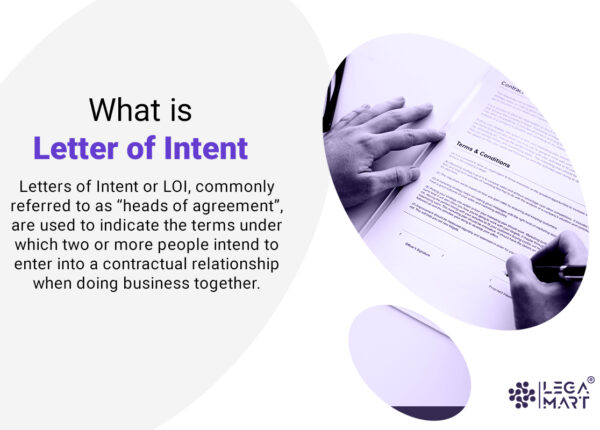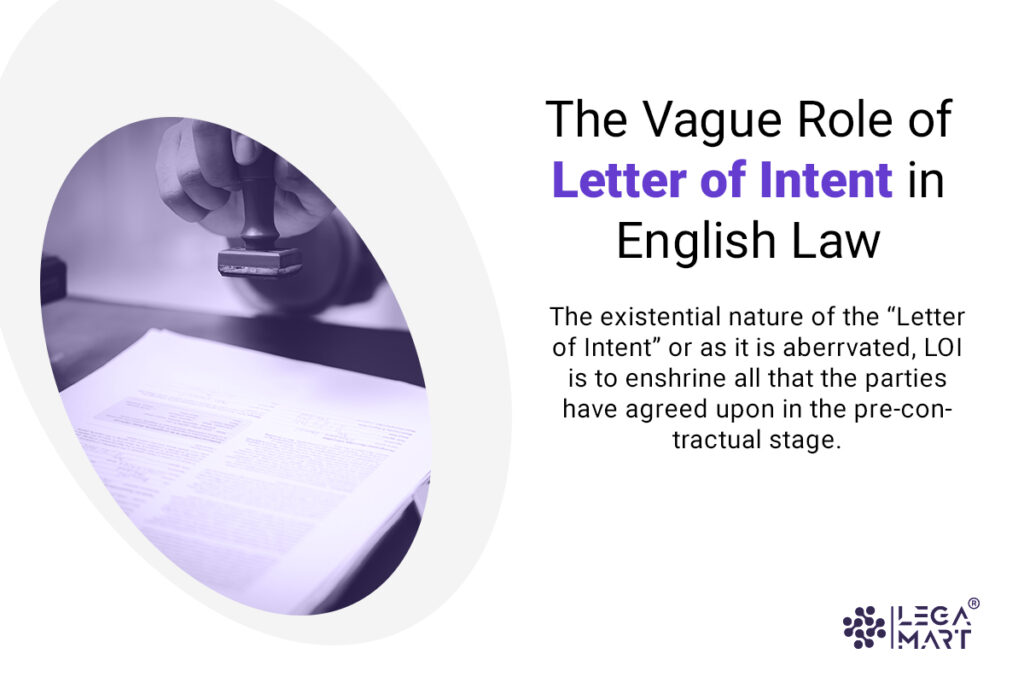The existential nature of the “Letter of Intent” or as it is aberrvated, LOI is to enshrine all that the parties have agreed upon in the pre-contractual stage. In some forms of contracts in which negotiation is extensive and complicated, the parties are more willing to sign at least one LOI to discard any ground of further disputes on preliminary agreements or to commence the work.
LOI may include a directive on further steps prior to the final contract in order to save time and energy. As far as HHJ Seymour QC was concerned: “LOI is a mythical beast in the construction industry, which imposes responsibility for the payment avoiding the contractual risk.”
What is Letter of Intent?

Letters of Intent or LOI, commonly referred to as “heads of agreement”, are used to indicate the terms under which two or more people intend to enter into a contractual relationship when doing business together.
The term “letter of intent” has no legal significance. Although, the courts have often treated so-called letters of intent as contracts capable of being enforced, so care must be taken when drafting them.
One legally binding clause that is normally included in a letter of intent is the confidentiality clause in which it is agreed that confidential information acquired during negotiations will not be disclosed to any third party or otherwise used.
However, the forms LOI is taken, and its implications are more than a mere entitlement to the payment. According to Clays and Dennys, there are other types of LOI with different effects. So, as a problematic issue, there is not a global forum for the substance and implication of LOI. This essay will discuss the various effects of LOI in the following titles:
- Different senses
- Arisen problems
- Problem avoidance methods
If you are interested in learning about various kind of agreement, the Articles below may become useful for you:
Understanding Licensing Agreement
Sale and Purchase Agreement: 8 Important Provisions to Consider
6 Essential Elements of Franchise Agreement
Different Definitions of Letter of Intent

There is not any general assumption of the substance of LOI. As HH Lloyd QC, in ERDC v. Brunel University, has pointed out LOI comes in all sorts of forms.
Some are mere expressions of hope; others are firmer but make it clear that no legal consequences ensue; others presage a contract and may be tantamount to an agreement, others are contracts falling short of the full-blown contract that is contemplated; others are, in reality that contract in all but name.”
In the realm of construction, LOI is utilized in some situations in which there is or likely is a general agreement on contract terms or there is a practical necessity for an early implementation of the work.
The substance of LOI depends on the court determination of the individual factual matrix and is from an all-or-nothing spectrum of the existence of an obligatory contract to the gray area of the quasi-contract.
The first tier of LOI is the one by which has been knowingly intended by the parties not to create any legal contract. However, as HHJ Coulson in Cunningham v. Collett & Farmer has pointed out, this is not the common form of LOI in the construction industry.
The ambit of LOI, referring to Turriff Construction v Regalia Knitting Mills, maybe a mere description that echoes the achieved primary agreements to avoid further misunderstanding. In this context, and where incompleteness or vagueness in some essential terms preclude the conclusion of the contract, LOI amounts to an agreement to agree in the future, which is a subsidiary of negotiation. According to HHL Ackner in the decision of the House of Lords in Walford v. Miles,‘‘… while negotiations are in existence either party is entitled to withdraw from those negotiations, at any time and for any reason”.
Hence, a bare agreement to negotiate, under the guise of LOI or any other similar format, does not contain any mandatory obligation to future contract because of the lack of the contractual core““…unless all material terms of the contract are agreed, there is no binding contract””
The second sense of the LOI is to create a binding contract. This contract is constituted by the express intention of the parties or judicial interpretation of the factual background.
As a matter of interpretation, the court would consider the construction of communication and all surrounding circumstances to determine whether all necessary elements of the contract have been concluded.
This contract is either temporary or permanent and, by its very nature, is either a standing offer that would constitute the unilateral (or if) contract or an ordinary executory contract.
The contract for the whole work may be formed by way of incorporating a standard form in pre-contractual relations or meeting the precedent conditions which were determined in the LOI.
The temporary or preliminary contract, which creates limited duties upon its individual terms, can be formed by way of the explicit intention of the parties or judicial determination while the‘‘conclusion of the contract for whole work’’ is pending, and certain terms are still to be agreed.
Therefore, it is visible in many construction cases, whenever the parties have decided on fundamental terms expressly or by conduct, especially when they have started the work, that courts are more willing to impose the objective test and decide on the existence of the contract.
The third tier of LOI is categorized under the quasi-contract. This is where the parties embark on the work having reliance on the existing LOI as the matrix of promises, but essential terms have not yet been sufficiently and definitely concluded.
So, in the lack of a contract, quantum meruit is the final remedy to reimburse the aggrieved party. As HHLJ Waller held in Whittle Movers v. Hollywood Express: “If the judge concluded no contract he would have been bound to consider the arguability of a restitution claim.”
This is the last resort where there was a request to commence the work before concluding the contract and one party knowingly got some benefits to detriment of the other party.
Arisen Problems
Lack of certainty over the concept and implication of LOI is a problematic issue because of the unknown risk of non-compliance.
It is relying on Kleinwort Benson v. Malaysia Mining Corporation Berhad with the presumption that the commercial entities have the intention to create legal relations while they enter into an agreement.
Therefore, the existence of an LOI is an indication of a contract that is not necessarily to be proved by positive evidence. This fact may give rise to uncertainty in the contract terms as it puts the fate of LOI before the court to decide on the construction of the contract and its terms.
The unperceived characteristic of LOI makes some hazards. First, the parties may lose control over the deal. Second, it may end up with unknown monetary subsequences. Third, LOI may give rise to non-liability for the work carried out.
First, the vagueness and incompleteness are advantageous and inappropriate windfalls of LOI. Although they keep the hands of the parties open to maneuver in their private relationship, it could be out of control wherever the court steps in.
However, courts try to find out the real intention of the parties, they apply an objective test to construe that.
Hence, the decision of the court is a matter of anxiety for the parties since there is a chance of imposition of an unwanted contract or modification in the mutual assumption of the parties.
This can be found in two cases. First, in Harvey Shopfitters v. ADI, the court imposed an intermediate form of contract in contrast with the assumption of the parties that had been bound by IFC 80 which was referred to in the LOI.
Second, in Diamond Build v. Clapham Park Homes, the court did not accept the argument that JCT, which was proposed in the course of negotiations, had been superseded by the LOI.
Furthermore, the most controversial case was and is RTS Flexible Systems v. Molkerei Alois Muller where the uncertainty in the applicable regime over an LOI is visible in the decisions of TCC, Court of Appeal, and Supreme court.
Therefore, LOI can be a challenging issue for both parties and the court to construe the existence and or imposition of a particular contract and the determination of incorporated terms.
The second arisen issue is the inherent feature of restitution which implies recovery, not a liability. This is visible in the British steel case where the court ruled on recovery under quantum meruit refusing the counterclaim for liability.
However, that decision did not cause injustice because the counterclaim for damages lacked the necessary legal foundation which may end up in injustice in some others.
The right to retention of a part of the payment for damages, as HHLJ Stocker held in Crown House Engineering v. Amec Projects, relying on its very nature is a matter of law of contracts and not restitution.
The beneath argument is that the defendant could have chosen the desired and undesired benefits by contracting, when he did not do so he lost the choice and should accept them both.
Furthermore, the recognized right of either party to desert the LOI may give rise to damages that could not recover on the basis of the repudiatory breach and would have additional costs for the client to find a replacement contractor to finish the work.
Therefore, the law of restitution may cause a black hole when implying the entitlement of the remuneration and not the liability for damages.
The third matter is unknown monetary subsequences of LOI in terms of the essence and amount of the payment. First, LOI cannot always guarantee remuneration under the law of restitution.
Nevertheless, the factual background in Regalian Properties v. London Docklands Development and Diamond Build v. Clapham Park Homes were different, the courts did not recognize any ground for recovery dealt with the fact that in both cases the applicant had carried out the work.
Second, lack of contract tempts the opportunistic party to use or abuse the existent deficit to reimburse under the law of restitution, especially when the given price was under the estimate or there was subsequent inflation in costs.
The contractor, in ERDC v. Brunel University, had tendered for £1.238m after having paid £1.266m and brought a semi-successful claim for an additional £0.9m relying on the contractual gaps derived from the expiration of LOI.
Hence, LOI may cause some monetary subsequences which jeopardize any prediction of the ultimate remuneration. In some cases, it was not enough basis for reimbursement, whereas in others the final cost was more than what had been tendered.
Problem Avoidance Methods
There are some remedies for arising disputes from LOI. Basically, any unwilling windfall of LOI can be prevented or managed by the creation of some clues which would put light on the four corners of the mutual intention.
However, the wise practitioners would rather avoid any further issues by maximum determination at the drafting stage, there are some ways to control the subsequences in the performance stage. It may be a function of what is meant from backward and forward reasoning of the factual background.
Thus, a free flow judicial interpretation could be barred prior to signing LOI by determination of intention through exclusion and exemption clauses and designation of bilateral counter responsibilities by utilizing a standard sort of contract.
Moreover, it can be managed in the performance stage by conduct and reliance.
The parties can avoid the creation of any unwanted contract in the pre-contractual stage by manifesting the expression of their intention. This method rebuts the presumption of intention to create legal relations and ruins the prerequisite of intention as a vital element of the contract.
It is a common assumption in negotiating memorandums that parties can preclude the enforcement of preliminary agreements with a “subject to contract” clause. The prima facie, relying on the judgment of HHLJ Neil in Bunker-Smith v. Freeza Meat, shows that the “subject to contract” clause did not result in a contract.
English courts are very reluctant to render an LOI as a contract where there is a subject to contract phrase. In addition, the formation of the contract or giving effect to it wholly or partially may be suspended through‘‘subject to ’’ clauses which create a conditional contract. Obviously, before meeting the precedent or subsequent condition, it is not possible to rule on the performance of the contract. Therefore, the‘‘subject to’’ clauses are offered to preclude the formation of the contract or to suspend it in order to avoid arising problems from LOI.
The second available remedy to control the subsequences of LOI is to define expenditure and liability caps by excluding and limiting terms. It is a contractual mechanism that prevents any further responsibilities arising from or connected to the LOI.
Nonetheless, the legal prerequisite is to presume that the LOI has formed a contract. A strong precedent supports this remedy yet a good example of the implication of caps in LOI can be found in Diamond Build v. Clapham Park Homes.
The court submitted that an LOI had formed a contract containing a cap in which there was not any liability beyond the expressed limitation. Hence, one benefit of the sense that the LOI is a contract is to use caps and other exclusion clauses to control further liabilities.
The best reliable way to control the subsequences of LOI is to use some sort of contract instead of LOI which includes provisions to manage the risks of early project involvements. These contracts minimize the risk of judicial interpretation as they contain semi-comprehensive provisions.
There are two types of contracts. Some of which have been designed to manage the pre-construction services like JCT 2016 PCSA which aims to carry out pre-construction services under a two-stage tender process and JCT 2016 PCSA/SA which embarks on the work before concluding the main contract.
Others include some terms for early involvement. NEC 4 option x22, PPC2000 (amended 2013) in appendix 3 part 1 provides minimum necessary conditions to avoid further disputes.
Reliance is an external standard and the last reasoning shot used to define mutual promises by the courts. Its significance evolves where the parties to LOI have wasted the drafting opportunity to identify their intention, and obviously do not have any control over the wording of the LOI.
Thus, they can control the subsequences by the act. Otherwise, act and reliance on the promises are judicial instruments to find a binding contract or quasi-contract through an objective judicial test.
Conclusion
LOI is a problematic instrument that by either way of construction or interpretation may take one of the three senses; non-binding memorandum, binding exclusory or unilateral contract, quasi-contract.
The interference of the courts to identify the nature and effects of LOI gives rise to subsequent problems. First, courts identify the substance of LOI through an objective test which can result in unwilling fruits.
Thus, it is not predictable whether the courts recognize the existence of a contract. It may also impose an unwanted contract or change the presumed contract to a new one. Second, restitution recovery is only for the reimbursement of costs and cannot imply any liability.
Hence, there is a potential ground to escape from subsequent liabilities. Third, the quantum meruit rule can put any prediction about the final cost in danger and give rise to financial uncertainty.
The above-mentioned problems can be avoided or managed. The parties can explicitly preclude or suspend the creation of a contract in whole or part by “subject to contract” or “subject to …” terms.
Another possible remedy is to utilize limitation or exclusion clauses that work as caps. Having a final or more detailed contract is the best controlling approach. JCT 2016 PCSA, JCT 2016 PCSA/SA, NEC 4, and PPC 2000 have been designed (or include some provisions) to regulate the early involvements and can be used to manage the risk of any early commencement of the work.
The last resort to avoid further issues is to control the performance of each party in order to prevent promise reliance and reliance as the practical intention.




